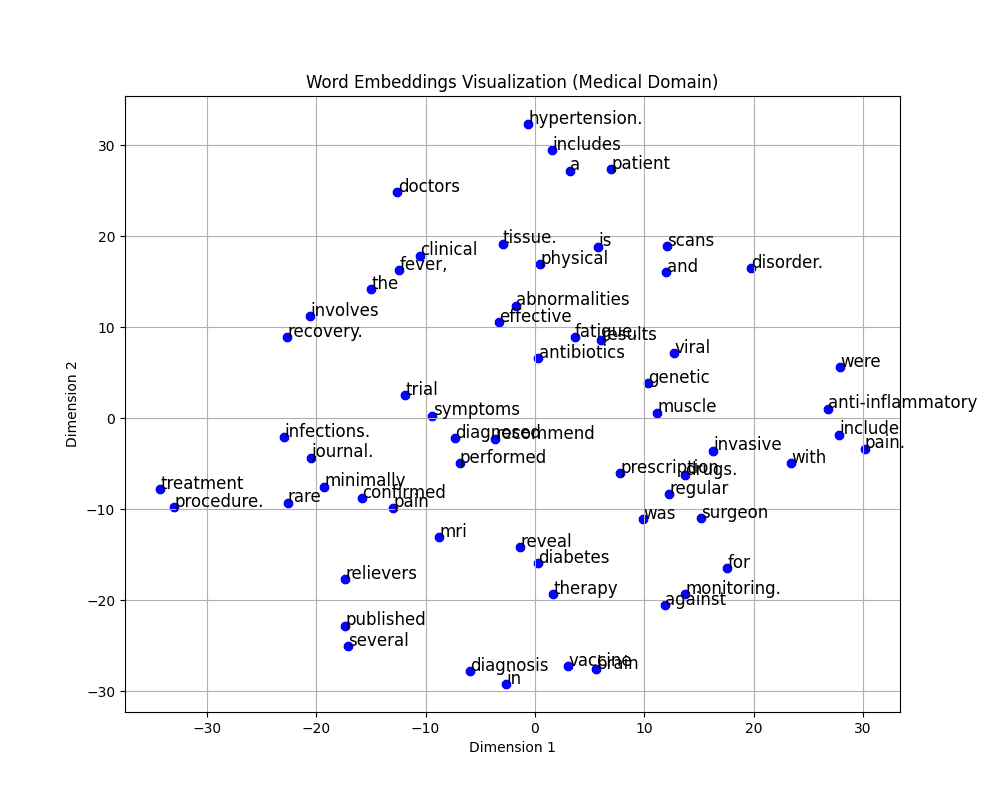3. Train a custom Word2Vec model on a small dataset. Train embeddings on a domain-specific corpus (e.g., legal, medical) and analyze how embeddings capture domain-specific semantics.
PROGRAM:
# Module or library install command (run this in terminal before running the script)
# pip install gensim matplotlib scikit-learn
import matplotlib.pyplot as plt
from sklearn.manifold import TSNE
import numpy as np
from gensim.models import Word2Vec
# Sample domain-specific corpus (medical domain)
medical_corpus = [
"The patient was diagnosed with diabetes and hypertension.",
"MRI scans reveal abnormalities in the brain tissue.",
"The treatment involves antibiotics and regular monitoring.",
"Symptoms include fever, fatigue, and muscle pain.",
"The vaccine is effective against several viral infections.",
"Doctors recommend physical therapy for recovery.",
"The clinical trial results were published in the journal.",
"The surgeon performed a minimally invasive procedure.",
"The prescription includes pain relievers and anti-inflammatory drugs.",
"The diagnosis confirmed a rare genetic disorder."
]
# Preprocess corpus (tokenize sentences and convert to lowercase)
processed_corpus = [sentence.lower().split() for sentence in medical_corpus]
# Train a Word2Vec model
model = Word2Vec(sentences=processed_corpus, vector_size=100, window=5, min_count=1, workers=4, epochs=50)
# Extract embeddings for visualization
words = list(model.wv.index_to_key) # List of words in the vocabulary
embeddings = np.array([model.wv[word] for word in words]) # Word embeddings for each word
# Dimensionality reduction using t-SNE
tsne = TSNE(n_components=2, random_state=42, perplexity=5)
tsne_result = tsne.fit_transform(embeddings)
# Visualization of word embeddings
plt.figure(figsize=(10, 8))
plt.scatter(tsne_result[:, 0], tsne_result[:, 1], color="blue")
# Annotating each point with the corresponding word
for i, word in enumerate(words):
plt.text(tsne_result[i, 0] + 0.02, tsne_result[i, 1] + 0.02, word, fontsize=12)
plt.title("Word Embeddings Visualization (Medical Domain)")
plt.xlabel("Dimension 1")
plt.ylabel("Dimension 2")
plt.grid(True)
plt.show()
# Analyze domain-specific semantics
def find_similar_words(input_word, top_n=5):
try:
similar_words = model.wv.most_similar(input_word, topn=top_n)
print(f"Words similar to '{input_word}':")
for word, similarity in similar_words:
print(f" {word} ({similarity:.2f})")
except KeyError:
print(f"'{input_word}' not found in vocabulary.")
# Generate semantically similar words
find_similar_words("treatment")
find_similar_words("vaccine")OUTPUT:
Words similar to 'treatment':
procedure. (0.27)
confirmed (0.15)
muscle (0.13)
monitoring. (0.12)
fatigue, (0.12)
Words similar to 'vaccine':
brain (0.26)
recommend (0.21)
procedure. (0.19)
therapy (0.19)
in (0.18)
